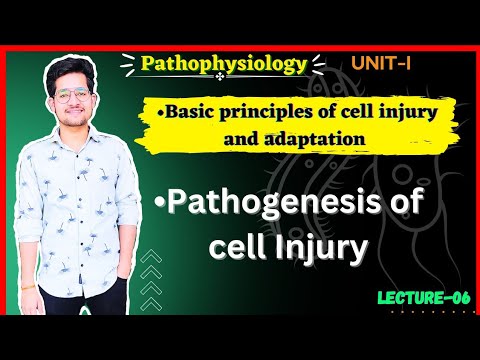Notes is on telegram channel join there link is in about section of our YouTube channel
Pathogenesis of Cell Injury in Ischemia / Hypoxic condition | Pathophysiology of Cell injury | Lec-06 |
▶️Playlist-
Pathophysiology-https://youtube.com/playlist?list=PLmyQZ1yZahwZ0sqRm-JKVFEBEr7hwzrse
NERVOUS SYSTEM-
Pharmaceutical organic chemistry playlist-
Podcast playlist-
#b_pharma
#pathophysiology
#pathophysiology_b_pharma_second_semester_unit_1
#pathophysiology_b_pharma_second_semester
#pathogenesis_of_cell_injury
#pathogenesis_of_cell_injury_in_hypoxic_condition
#pathogenesis_of_cell_injury_in_Ischemic_condition
#nurturing_medicos
#pathophysiology_b_pharma_second_semester_playlist
Pathogenesis of Cell Injury due to Hypoxia and Ischemic Conditions:
Hypoxia and ischemia are conditions characterized by inadequate oxygen supply to tissues, leading to cellular dysfunction and injury. The pathogenesis of cell injury under these conditions involves a complex interplay of various cellular and molecular mechanisms. Let’s explore the key steps in the pathogenesis of cell injury due to hypoxia and ischemia:
1. Oxygen Deprivation: Hypoxia and ischemia occur when there is an insufficient supply of oxygen to the tissues. This can happen due to reduced blood flow (ischemia) or decreased oxygen content in the blood (hypoxia). Oxygen is essential for cellular metabolism and energy production, and its deprivation triggers a cascade of events leading to cell injury.
2. ATP Depletion: Oxygen deprivation impairs aerobic respiration, the primary pathway for generating ATP (adenosine triphosphate), the cellular energy currency. Without sufficient oxygen, cells resort to anaerobic metabolism, resulting in the inefficient production of ATP. This leads to an energy crisis within the cells, disrupting critical cellular processes.
3. Accumulation of Reactive Oxygen Species (ROS): Oxygen deprivation can result in the accumulation of reactive oxygen species (ROS) within the cells. ROS are highly reactive molecules that can damage cellular structures, including proteins, lipids, and DNA. Increased ROS levels contribute to oxidative stress, further exacerbating cellular injury.
4. Calcium Dysregulation: Hypoxia and ischemia disrupt the delicate balance of calcium ions within cells. Normally, calcium ions are tightly regulated and play a crucial role in numerous cellular functions. However, oxygen deprivation leads to an influx of calcium ions into the cells, disrupting cellular homeostasis. Elevated intracellular calcium levels can activate various enzymes and pathways that contribute to cellular injury.
5. Mitochondrial Dysfunction: Mitochondria, known as the “powerhouses” of the cell, are particularly susceptible to hypoxic and ischemic injury. Oxygen deprivation disrupts mitochondrial electron transport and oxidative phosphorylation, impairing ATP production and causing mitochondrial dysfunction. Dysfunction of these vital organelles leads to the generation of more ROS and further compromises cellular energy production.
6. Inflammatory Response: Oxygen deprivation triggers an inflammatory response in the affected tissues. Hypoxia and ischemia induce the release of pro-inflammatory mediators, such as cytokines and chemokines, attracting immune cells to the site of injury. The inflammatory response can contribute to tissue damage through the activation of additional damaging pathways and the release of toxic substances.
7. Cell Death: Prolonged or severe hypoxia and ischemia can ultimately lead to cell death. Cells may undergo apoptosis, a programmed cell death mechanism characterized by controlled cell dismantling. In more severe cases, necrosis, an uncontrolled and inflammatory form of cell death, may occur. The extent and type of cell death depend on various factors, including the duration and severity of oxygen deprivation.
Understanding the pathogenesis of cell injury due to hypoxia and ischemia is crucial for developing therapeutic strategies to mitigate the damage. Approaches that target oxygen delivery, reduce oxidative stress, and modulate inflammation hold promise for protecting cells from injury and improving outcomes in conditions associated with hypoxia and ischemia.
Thank for seeing!
Subscribe
#Nurturing_Medicos / @vishal_aditya
source



